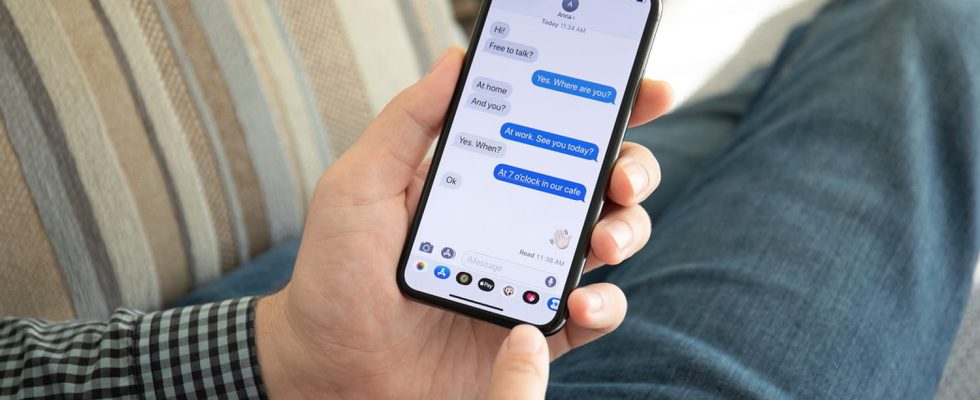After opposing RCS for years, Apple has decided to support the protocol on its iPhones from January 2024. But the bubble color problem will not disappear…
Despite all its efforts, Google is struggling to generalize RCS – Rich Communication Services –, in particular because of Apple which stubbornly refuses to implement this communication protocol intended to replace SMS and MMS for the exchange of messages on mobile. The Internet giant has continually asked Apple for support for the messaging standard in iMessage, but the Apple firm prefers to keep its proprietary format. But it seems that he finally succeeded in making her bend since, in A press release published on November 16, Apple announces that, sometime in 2024 – probably under iOS 18 at the latest – RCS will be added to its platforms. “We believe the RCS Universal Profile will provide a better interoperability experience compared to SMS or MMS. This will work in parallel with iMessage, which will continue to be the best performing and most secure messaging experience for users. ‘Apple’, explains Steve Jobs’ firm. A giant step forward for messaging interoperability, even if certain details cloud the picture.
RCS: a universal communications protocol
The RCS (for Rich Communication Services) is a communication protocol intended to replace the aging SMS and MMS for the exchange of messages on mobile. Developed since 2012 by the main telephony players, RCS is both more sophisticated and richer than SMS, with functions similar to those offered by apps like WhatsApp, Signal, Telegram or iMessage. Like these services, RCS goes through the Internet, more precisely, through mobile data, while SMS uses the 2G cellular network. In fact, like these instant messengers, it offers much more flexibility and functions than traditional SMS and MMS: receipt and reading acknowledgments, real-time location and input indicator, sending high quality photos and videos, group chats, video calls, etc. In addition, like SMS, it does not depend on any specific company or any particular app, unlike WhatsApp, Messenger or iMessage: simply use a compatible application – such as Google Messages – to exchange instantly, regardless of the telephone operator. It is not a proprietary format, but an open protocol. In short, it combines all the advantages of a standardized protocol like SMS with those of a “private” and modern messaging app.
However, despite its qualities and its promises, the RCS struggles to convince. It has not been massively adopted by operators, who still seem to be content with the SMS-MMS duo and instant messaging apps. Only Google seems to want to promote it, through its Messages application, often installed as standard on Android phones. To abandon SMS in favor of RCS, manufacturers and mobile telephony players need a strong boost, which Apple could well provide.
RCS in iMessage: so, blue bubble or green bubble?
But why such an about-face after years of refusal? This is certainly due to the pressure emanating from the European Union. Indeed, the legislation on digital markets (DMA) imposes a certain level of interoperability between messaging services. The RCS can be this common gateway. However, by chance of the calendar, November 16 corresponds to the deadline for appealing his registration on the DMA list. By adopting RCS, Apple could attempt to prove that its iMessage already complies with European standards and does not need to be regulated. A way to be on point, without completely abandoning your position.
Because the Apple company is not going to abandon iMessage. The integration of the RCS will be done “alongside iMessage”. Simply put, messages sent between Apple devices will continue to use iMessage while those between Android devices will use RCS rather than SMS, in order to benefit from the benefits of the new protocol. As a result, the opposition between blue bubbles, sent from an iPhone, and green bubbles, sent from an Android smartphone, will continue to exist, even if there will be a smaller gap in terms of functions between the two protocols. And that remains a problem…
Indeed, the color of the text bubble has become an important social marker, particularly across the Atlantic, to such an extent that young people fear being excluded from social groups if they do not display an iPhone. In the United States, 87% of the famous Gen Z are on iOS. For others, it’s impossible to go unnoticed, because messages sent from an Android device are displayed in green, while those sent from an iPhone are displayed in blue. Therefore, teenagers fear being excluded from their social circle if they use an Android smartphone. A “social selection” that reaches down to the romantic strata – and that’s without counting the numerous cases of school harassment, which Apple will continue to fuel (see our article). Result: social pressure is a real selling point that Apple will certainly not deprive itself of! Afterwards, it is true that in terms of security, iMessage is a little better off, since the messages are end-to-end encrypted, which is not the case, by default, for RCS messages. Apple has nevertheless indicated that it wants to work with the GSMA association to improve the protocol, making it more robust and more secure.
